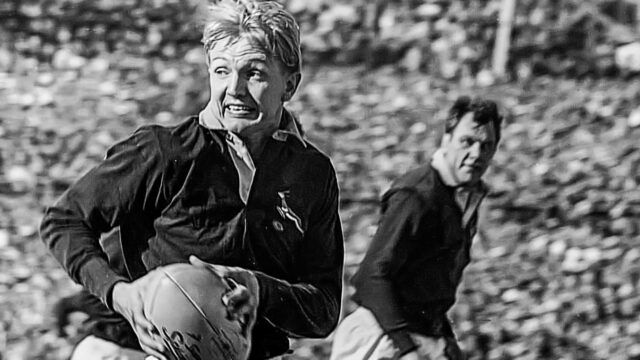Jo Bach of Ystradgynlais
They have a presence, these lumpen yet dignified figures, and although their faces are obscured and anonymous, they are easily identifiable as working people: miners, farm workers and women well-used to hard work.
They all seem a little careworn, but are serene and unbowed – ready to face the next shift, to lift the next load or to sew the next garment. Even the animals he paints are beasts of burden.
Josef Herman, who produced these works, will forever be associated with Wales, although he only lived there for eleven years. He was born in Warsaw in 1911 to a working-class Jewish family: an opening chapter which fills us today with a sense of foreboding. He stayed in Poland long enough to train at Warsaw’s School of Art and Decoration and to exhibit his work in the city. As a young Jewish intellectual, he was acutely aware of the growing threat of anti-Semitism and war and, fleeing to Brussels in 1938, became a refugee, losing sight of his family and his heritage. He eventually found himself in Glasgow and then in London, working on paintings and drawings through which he sought to capture his childhood memories of Jewish life in Warsaw. In 1942, he learned through the Red Cross that his entire family has been murdered by the Nazis. Grief-stricken and lost, emotionally spent and in creative despair, he wrote of this time:
“The nostalgia for my childhood years had burnt itself out and nothing had taken its place, except a vague feeling for big forms and a cry within me for a new belief in man’s serenity.”
The turning point for Herman came when he visited Wales in 1944, not in search of the sublime or picturesque, but simply for a place where he could start his recovery from the trauma of grief and displacement. The intended short stay extended to eleven years. His moment of epiphany came to him on the first evening he spent in Ystradgynlais. The scene, a group of miners crossing a bridge in the evening sunlight, was at once both mundane and miraculous. It satisfied his longing for the “big forms” and “serenity” he felt had been missing from his work. He later wrote:
“For a split second their heads appeared gaunt against the full body of the sun… with the light around them, the silhouettes of the miners were almost black… The magnificence of the scene overwhelmed me… it became the source of my work for years to come.”
It is a vision that can be seen to have brighter echoes in the figure haloed in light which is included in our forthcoming Welsh Sale.
Josef Herman stayed in Ystradgynlais, working first in charcoal and ink, then pastel and finally in oil, gradually capturing the colours of the South Wales coalfield and its communities, which had previously been presented to the world only through the documentary monochrome of photography and film. He revelled in the shifting colours of Wales: the blue rain-washed roof tiles and asphalt, transforming into rich, coppery tones in the evening sunlight. He was similarly struck by the red and blue buses, and the red and gold sign of the local chip shop. These mundane sights of a Welsh mining village became more compelling as he decided that this was a place that could provide him with new themes and sustain his creativity.
But the shift was not only aesthetic: the community too, made a deep impression on him. The closeness and interdependency of the villagers inspired him to paint his anonymous miners as “more real than portraits”: a distillation of people and location. The mining community is presented as a group of people working together, united by a sense of mutual support and purpose. The coal industry was, of course, essential to the war effort at this time. The people of Ystradgynlais in turn welcomed him warmly, naming him “Joe bach” almost immediately.
From this small corner of the Swansea Valley, Herman’s reputation grew steadily. In 1951, he contributed two murals to the Festival of Britain: a scene of South Wales, and the monumental Miners Crouching. Following his move from Ystradgynlais in 1955 he was awarded the Gold Medal for Fine Art at the National Eisteddfod in 1962, received an OBE for services to British Art in 1981 and was elected a Member of the Royal Academy of Arts in 1990.
The move from Wales seems to have been reluctant and protracted. Some sources suggest the weather had become detrimental to his health. Interestingly, Herman’s widow, in her introduction to a book of his writings, notes that the autobiography section finishes at the date he left Ystradgynlais. She wonders whether the wrench of leaving the village evoked memories of his flight from Warsaw back in 1938.
Unlike his painful memories of Poland, however, Josef Herman never chose to forget what Ystradgynlais had given him. Living in Suffolk and later London, he returned time and again to his motif of miners. And on his travels – whether to Europe, Israel, the USA or Mexico – his colours and his portrayal of people and their environment retain the vision of his Welsh epiphany.
The trauma of his youth and the subsequent years of being plagued by survivor guilt left Josef Herman wary of all that was frivolous. He resolved to “look only at paintings purged of all trivia and inessentials.” He appreciated and collected African tribal art and Pre-Columbian artefacts, finding in them a parallel to his own stark aesthetic. He writes about his work in sombre terms, of painting people “nourished by tradition, formed by labour and moved by aspiration.” The memory of his own tradition was too painful to dwell upon, but he found redemption through work and aspired to the end to find (in his own words) a “belief in man’s serenity.”
I mentioned at the beginning that Herman’s work has a presence. It is, I think, a deeply soothing and unsentimental presence: an austere reminder of the goodness of humanity, which he caught a glimpse of in Ystradgynlais and which went on to inform all that he produced thereafter.
by Ruth Richards
Below are but a few of the nineteen lots by Josef Herman in the November Welsh Sale







